Four of the best indoor kayaking sessions for ergometer training

With many of us in lockdown, the kayak ergometers are coming out to keep fit, sane and build form for future races. Kayak ergometers always have good weather, no wind and are easily accessed if you have them in the home. Sessions on an ergo provide paddlers with a quick and effective way to implement specificity into their training. The non-existent glide of your kayak across the water means that to keep the computer ticking over, you have to keep pulling and working hard to get the same results. To enjoy a kayak ergometer, you have to enjoy hard work.
However, there’s no point simply spinning your arms around while sitting on an ergo. To get the most out of your stationary paddling, as you should when on the water, you should start with a program and have specific sessions planned for the ergo. Being realistic this needs to be customised to your current level of fitness, and your goals.
There are many fitness apps and coached sessions to purchase, but if you want to keep subscription-free or don't have a coach to consult, we’ve got a few ideas for you to try below.
Finding your maximum heart rate
There are many different ways of measuring training and many of these depend on what you have access to or what you have been trained in. Heart rate, stroke rate and rate of perceived exertion (RPE or levels 1-10) being the most common.
On the KayakFirst ergometer, there is the choice of 2 presets being speed or pace/1000m. This is similar to what many paddlers use on their GPS watches while paddling on the water.

Not all ergometers have computers as advanced so a heart rate monitor can be a good way to measure your effort. To use this you will need to find your maximum heart rate (MHR) before you get started. This will be used to gauge how hard you are working during intervals, based on the percentage of the maximum heart rate that your heart rate monitor is reading.
A simple estimate of your maximum heart rate is the commonly used formula: 220 minus your age. For example 220 – 35-year-old = 185 MHR (this being 100%) then work out 70% etc of this is to identify your levels.
To test and identify your maximum heart rate you will need to use a heart rate monitor, training partner or housemate to note the maximum heart rate.
- Warm-up for 10 – 15 minutes paddling on the ergometer building the pace to your usual training effort.
- Paddle as hard as possible for 10 minutes, choosing a time trial pace where you can last the time at this high pace but no more than the 10 minutes. Increase the stroke rate in the final minute pushing as hard as possible to produce a maximum heart rate reading on the monitor.
- Keep paddling on an easier resistance and stroke rate for 10 – 15 minutes to slow down your heart rate again and cool down.
Ergometer sessions for you to try
There are many sessions you can do on a kayak ergo but finding the session that best fits in with your needs and goals is important. Here’s a look at a few different sessions you can do. Remember these are suggestions and may not suit every style of paddling or your specific goals. We would love to hear your ideas and what they are aiming for in the comments below.
Each of the below sessions should be adjusted to your own level of fitness. To modify any of the sessions you can play with the frequency of sessions, duration of each effort or increasing the sets of repetitions and modifying the intensity to suit your needs.
The sessions below will use the percentage of MHR to be transferrable to more paddlers.
Warm-up and cool down before and after a kayak ergo session
To begin any ergometer session, take a 10-15 minute period building the work every 2 minutes from easy to what feels like a normal training effort in the final 2 minutes. Once you’ve finished on the ergo, it is tempting to attack the fridge for food or a cool drink but you will want to make sure that you have continued paddling on the ergo for 10 minutes at an easy effort to make sure your muscles are properly cooled down to reduce muscle aches the next day.
Stay cool and hydrated while paddling your ergometer
As you are paddling indoors, you don’t get the benefit of the cool air passing you or the spray (or splash) of water from the paddler next to you. So it gets very hot and very sweaty very quickly.
If possible, try to set up a fan in the room during the sessions as it will get sweaty. Having a bottle of water handy and a towel to wipe away your sweat is handy too.
Descending Pyramid kayak ergometer training session
Increasing ever so slightly the efforts shorten as the intensity increases. This can be achieved by maintaining a set stroke rate, speed (0.5km increases are good) or increasing the resistance on your kayak ergometer. After each effort give yourself a 1-minute rest just spinning at an easy stroke rate. We recommend not increasing the workload too early to save yourself to make the final high intensity efforts.

Tempo kilometres kayak ergometer training session
Tempo training like this will be a good measure of your consistency. If you repeat this set you can measure the consistency of the time for each kilometre done at each level 70%, 80%, and 90% efforts. If they are all the same speed, you’re doing well to measure yourself with fatigue.

Stepped efforts
This stepped interval session is not for the faint-hearted. Each ‘on’ effort is at 90% MHR or greater with the ‘off’ being at a steady coasting speed of 70% MHR. Enjoy the steady time while it lasts, the fitter paddlers will shine through as the steady time reduces and the time on the harder efforts increases.

Mona Fartlek VO2 training session
This session was originally a running session developed by Australian Marathon runner Steve Moneghetti to increase his pace for 5km races. However, it is perfect for increasing speed on the water too and is perfect if you only have a short time to train.
These are 100% MHR efforts followed by a steady recovery pace and are great to build speed and your threshold. Those who are fitter will have a higher steady recovery pace and the goal should be to increase the pace of the “offs” over time. Give yourself at least 5 minutes of recovery between each set if you want to do more than one set.

Many paddlers have a love/hate relationship with kayak ergometers. Some paddlers only use them when they absolutely have to such as winter or in quarantine Covid-19, while others use them all year round as part of their regular program. Regardless of how you feel about yours, you can’t deny the performance improvements they offer.
The reason many dislike the paddle ergometer is that the sessions are hard and relentless. With constant resistance on the paddle shaft there is often no respite. But, for the same reason, using your ergo has a big impact on your paddling, leading to large fitness improvements and easy access to specific paddle training inside your home.
- Kieran Babich

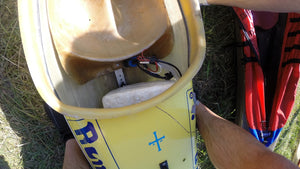
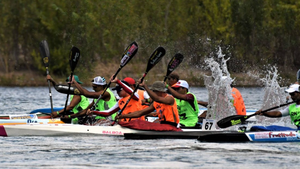
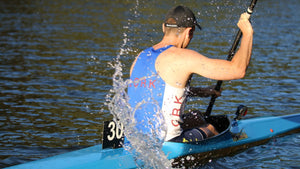
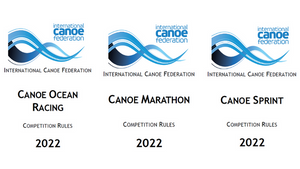
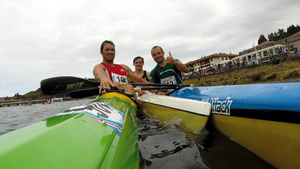
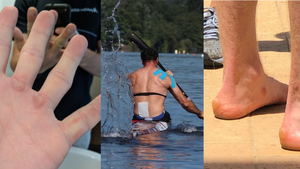
Comments 0